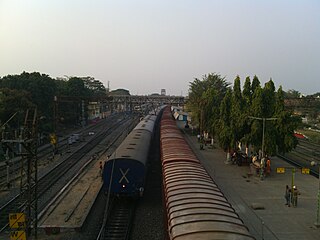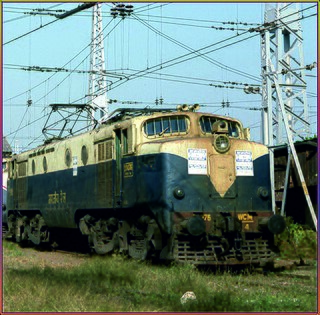Related Research Articles

Indian locomotive class YAM1 is the first, and so far only class of metre gauge (Y), Alternating Current (A), mixed traffic (M) electric locomotive in India. Twenty were built in 1964–66 by a Japanese consortium led by Mitsubushi.

Sheoraphuli Junction is a Kolkata Suburban Railway station on the Howrah–Bardhaman main line and is located in Hooghly district in the Indian state of West Bengal. It serves Sheoraphuli area & northern part of the Serampore City. The Sheoraphuli–Tarakeswar branch line meets Howrah–Bardhaman main line at Sheoraphuli.

The Indian locomotive class WDM-4 is a class of diesel-electric locomotive that was developed in 1962 by Electro-Motive Diesel for Indian Railways. The model name stands for broad gauge (W), Diesel (D), Mixed traffic (M) engine, 4th generation (4). They entered service in 1962. A total of 72 WDM-4 locomotives were built between 1961 and 1962.

The Indian locomotive class WCAM–3 is a class of dual-power AC/DC series electric locomotives That was developed in 1997 by Bharat Heavy Electricals Limited used in the Indian Railways system. They are the third locomotives from the WCAM class. The model name stands for broad gauge (W), DC Current (C), AC Current (A), Mixed traffic (M) locomotive, 3rd generation (3). They entered service in 1997. A total of 53 WCAM-3 were built at BHEL between 1997 and 1998, which made them the most numerous class of mainline dual-power AC-DC electric locomotive. They were specifically designed for use by Central Railways in the Ghat section towards Nashik and Pune.

The Indian locomotive class WCG-2 is a class of 1.5 kV DC electric locomotives that was developed in the late 1960s by Research Design and Standards Organisation (RDSO) and Chittaranjan Locomotive Works (CLW) for Indian Railways. The model name stands for broad gauge (W), DC Current (C), Goods traffic (G) engine, 2nd generation (2). They entered service in February 1971. A total of 57 WCG-2 were built at CLW between 1978 and 1983, which made them the most numerous class of DC electric locomotive.

The Indian locomotive class WAM-1 was a class of 25 kV AC electric locomotives that was developed in the late 1950s by the Groupement 50Hz for Indian Railways. The model name stands for broad gauge (W), AC Current (A), Mixed traffic (M) locomotive, 1st generation (1). They entered service in 1960 thus making them India's first AC electric locomotive. A total of 100 WAM-1 were built by the European consortium between 1959 and 1961, which made them the most numerous class of mainline electric locomotive until the WAG-1.

The Indian locomotive class WAM- 2/3 was a class of 25 kV AC electric locomotives that was imported from Japan in the 1960s for Indian Railways. The model name stands for broad gauge (W), AC Current (A), Mixed traffic (M) locomotive, 2nd generation (2). A total of 38 WAM-2/3 locomotives were built by The Japanese Group between 1960 and 1964. They entered service in 1960.

The Indian locomotive class YDM-5 is a class of diesel-electric locomotive that was developed in 1964 by General Motors (GM-EMD) for Indian Railways. The model name stands for Metre gauge (Y), Diesel (D), Mixed traffic (M) engine, 5th generation (5). They entered service in 1964. A total of 25 YDM-5 locomotives was built between 1963 and 1964.

The Indian locomotive class YDM-3 is a class of diesel-electric locomotive that was developed in 1964 by GM-EMD for Indian Railways. The model name stands for Metre gauge (Y), Diesel (D), Mixed traffic (M) engine, 3rd generation (3). They entered service in 1962. A total of 30 YDM-3 locomotives was built between 1961 and 1962.
The Indian locomotive class WCM-6 is a class of 1.5 kV DC electric locomotives that was developed in 1995 by Chittaranjan Locomotive Works (CLW) for Indian Railways. The model name stands for broad gauge (W), Direct Current (C), Mixed traffic (M) engine, 6th generation (6). They entered service in 1996. A total of 2 WCM-6 locomotives was built at CLW in 1995. Currently they haul only departmental trains and do shunting duties.
The Indian locomotive class WCM-5 is a class of 1.5 kV DC electric locomotives that was developed in 1956 by Chittaranjan Locomotive Works (CLW) for Indian Railways. The model name stands for broad gauge (W), Direct Current (C), Mixed traffic (M) engine, 5th generation (5). The trains were the first locomotive of any kind fully developed and built in India. They entered service in 1961. A total of 21 WCM-5 locomotives was built at CLW between 1961 and 1963.

The Indian locomotive class WCM-4 is a class of 1.5 kV DC electric locomotives that was developed in 1956 by Vulcan Foundry and English Electric for Indian Railways. The model name stands for broad gauge (W), Direct Current (C), Mixed traffic (M) engine, 4th generation (4). They entered service in 1961. A total of 7 WCM-4 locomotives was built at England between 1956 and 1957.

The Indian locomotive class WCG-1 is a class of 1.5 kV DC electric locomotives that was developed in the late 1920s by Vulcan Foundry and Swiss Locomotive and Machine Works (SLM for Indian Railways. The model name stands for broad gauge, Direct Current, Freight traffic engine, 1st generation. They entered service in 1930. A total of 41 WCG-1 was built at England between 1928 and 1929.

The Indian locomotive class WCM-1 is a class of 1.5 kV DC electric locomotives that was developed in 1954 by Vulcan Foundry and English Electric for Indian Railways. The model name stands for broad gauge (W), Direct Current (C), Mixed traffic (M) engine, 1st generation (1). They entered service in 1955. A total of 7 WCM-1 locomotives were built in England between 1954 and 1955.

The Indian locomotive class WCM-3 is a class of 1.5 kV DC electric locomotives that was developed in 1958 by Hitachi for Indian Railways. The model name stands for broad gauge (W), Direct Current (C), Mixed traffic (M) engine, 3rd generation (3). They entered service in 1958. A total of 3 WCM-3 locomotives were built in Japan in 1958.

The Indian locomotive class WAG-2 was a class of 25 kV AC electric locomotives that was imported from Japan in the 1960s for Indian Railways. The model name stands for broad gauge (W), AC Current (A), Goods traffic (G) locomotive, 2nd generation (2). A total of 45 WAG-2 were built by The Japanese Group between 1964 and 1965. They entered service in 1964.

The Indian locomotive class WCP-1 is a class of 1.5 kV DC electric locomotives that was developed in late 1920s by Swiss Locomotive and Machine Works (SLM) for Indian Railways. The model name stands for broad gauge (W), Direct Current (C), Passenger traffic (P) engine, 1st generation (1). They entered service in 1930. A total of 22 WCP-1 was built at England between 1928 and 1929.

The Indian locomotive class WCP-4 is a class of 1.5 kV DC electric locomotives that was developed in late 1920s by Swiss Locomotive and Machine Works (SLM) for Indian Railways. The model name stands for broad gauge (W), Direct Current (C), Passenger traffic (P) engine, 1st generation (1). They entered service in 1930. A single WCP-4 was built at England between 1928 and 1929.
The Indian locomotive class WCP-3 is a class of 1.5 kV DC electric locomotives that was developed in late 1920s by Hawthorn Leslie for Indian Railways. The model name stands for broad gauge (W), Direct Current (C), Passenger traffic (P) engine, 3rd generation (3). They entered service in 1930. A single WCP-3 was built at England between 1928 and 1929.

The Indian locomotive class WCP-2 is a class of 1.5 kV DC electric locomotives that was developed in late 1920s by Swiss Locomotive and Machine Works (SLM) for Indian Railways. The model name stands for broad gauge (W), Direct Current (C), Passenger traffic (P) engine, 2nd generation (2). They entered service in 1938. A single WCP-1 was built at England in 1938.
References
- ↑ "Report of the expert Committee on Coal Consumption on Railways, 1958". INDIAN CULTURE. Retrieved 29 April 2020.
- ↑ Gudgin, D.S.E. (1976). Vulcan Foundry Locomotives 1832–1956. Truro: Bradford Barton. ISBN 978-0-85153-215-8.
- ↑ History of EMU on Eastern Railway and South Eastern Railway, South Eastern Railway, 27 November 2018
- ↑ "[IRFCA] Indian Railways FAQ: Locomotives - General Information - I". www.irfca.org. Retrieved 18 April 2020.
- ↑ "Refer pg 260" (PDF).
- ↑ Express train in India with commuters in the doorways, 1960's. Archive film 61232 , retrieved 21 May 2020



